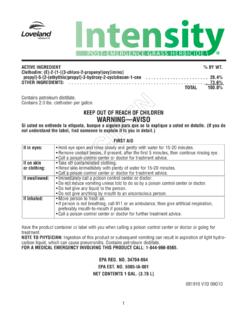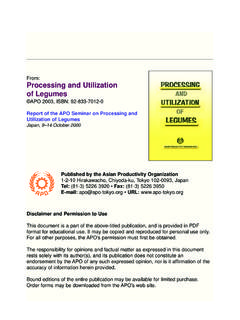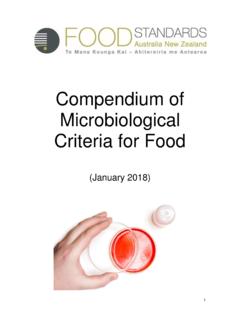Transcription of New Zealand domestic vegetable production: the …
1 2017 New Zealand domestic vegetable production : the growing storyHorticulture New Zealand ForewordHorticulture New Zealand s vision is healthy food for all forever. Now, more than ever, people are seeking out healthy food and lifestyles. Indications from the health sector are that diet is linked to long-term health outcomes. The ideal diet includes plenty of fresh fruit and addition to seeking out healthy food, people worldwide are making purchasing decisions based on values. These values might include wanting to know where the food comes from, and that it is sustainably and ethically produced. Growers and food retailers need to provide shoppers with this parallel, there is a perfect storm brewing for New Zealand s supply of healthy food. Prime fruit and vegetable growing land is being squeezed by rapid growth in towns and cities and high demand for new housing. Emotional battles over water have the potential to leave growers high and dry.
2 Changes in weather patterns across regions and extreme unseasonal weather events such as rain, hail, snow, frost or drought becoming more frequent and damaging, are impacting the supply of fresh, healthy food. When supply is short and demand high, prices are subject to wide variations. This can potentially put healthy food out of reach for some believe it is time to take stock. There is an assumption that New Zealand is a land of plenty and we will always have enough locally-grown food to feed our population, supplemented by imported food where there is demand. But things are changing, fast. We need to look closely at our domestic food supply and be sure that town, city and regional planning decisions are seen in the context of impacting the whole of New Zealand s food solution is not as simple as picking up and moving growing operations somewhere else, or moving growing indoors and vertical.
3 Horticulture started on the outskirts of towns and cities to ensure fresh produce could get to market quickly, without spoiling. Each growing area is an ecosystem that has developed over generations and supports local, regional and the wider New Zealand economy in many ways, including employment. Growers are definitely looking at how they can do more with less. The population they feed is growing, but access to land and water is challenging. Our growing areas and the businesses that grow vegetables in New Zealand have consolidated meaning the need to protect them for the future is more important than ever. Science and technology is driving change and helping meet consumer demands. People all over the world Julian Raine President, Horticulture NZMike Chapman Chief Executive, Horticulture NZwant our food and exports are vital to the growing economy, but are we in danger of leaving New Zealanders with not enough locally grown food to eat?
4 This report is the first step in taking stock of what we need to continue to grow the vegetables that form the staple base of healthy New Zealanders diets. It is part of a body of evidence Horticulture New Zealand is compiling to persuade decision-makers across all levels of government that we need a domestic food security policy. Before more houses are placed on fertile and unique growing land and more decisions are made about water, we want there to be a pause for breath and some big picture ForewordIan Proudfoot KPMG Global Head of AgribusinessOn a global scale, New Zealand s agri-food sector is made up of a plethora of niche, boutique and artisan businesses. Greater value can be generated by joining the dots between the producers and the communities from which our products originate and those that ultimately experience the a world of almost limitless choices for premium consumers, something being facilitated by rapidly evolving technologies, New Zealand s vegetable and fruit producers need to create experiences that fully engage with their consumers.
5 Keeping domestic consumers enthusiastic and passionate about our products, will help our nation to flourish not only as a nation, but on the global stage. Capturing value relies on telling the stories that underlie the products we grow. These stories must be substantive and leverage all aspects of the products we grow. The provenance story of our products is a key differentiator for both domestic and international consumers, with traceability back to the grower a fundamentally important attribute. As technology evolves, New Zealand has an opportunity to add value to our natural products through securing our reputation as a sustainable and ethical nation. Delivering nutritious produce that is affordable by all New Zealanders is a key enabler to encourage a wider health discussion around healthy diets and food options. The industry is working collaboratively to lead science and technology to secure and maintain market leading positions.
6 Connecting the passion of the producer, and their desire to create amazing products in the way that is best for their land, family, community and country, to the consumer will differentiate a product and help secure a premium. This is ultimately connecting farmers with their reason for being. Most forget to acknowledge our farmers as the providers of our food and our health and, ultimately, as those who support society to function effectively. 4 | HORTICULTURE NEW ZEALANDE xecutive SummaryNew Zealand horticulture is big business, and growing fast. With an industry value of $ billion (excluding wine), we export 60 percent of what we grow, that is, $ billion in value to 124 countries. Exports increased by 40 percent from June 2014 to 2016. The 5,500 commercial fruit and vegetable growers employ about 60,000 people and the demand for workers across the skill spectrum is outstripping growth doesn t come without some growing pains.
7 While there has been a strong focus on more exports, with primary production still being New Zealand s big economic driver, what is happening to our domestic food supply? Trends indicate a strong desire by consumers to buy fruit and vegetables that are locally grown, and to understand what has gone into producing their food. While some will always buy on price, a section of the population seek more information before they Consumer New Zealand survey in early 2017 showed that 71 percent of New Zealanders want to know where their fruit and vegetables come from and 70 percent also want to buy New Zealand -grown. Consumers want mandatory Country of Origin Labelling (CoOL) for fresh fruit and vegetables, something New Zealand lags behind other countries on it is only voluntary here and not law. Off shore, our food commands a premium because it is known to be safe, high-quality and healthy. There is a lot of talk about selling the New Zealand story, yet we don t even label our own fruit and vegetables in our own country.
8 Tourists who have bought into the clean and green image and travelled all the way here, struggle to get a New Zealand food make-up of New Zealand s population is changing, with city dwellers no longer having connections with rural communities that they once might have had. There is not the understanding of what goes into getting fresh food onto their plates, but there are a lot of demands for convenient packaging and year-round availability at an affordable Zealand growers are early adopters of science and technology to match changes in consumer demands. There has been considerable investment in all aspects of production and some of our packhouses are driving efficiencies and improving quality with cutting-edge technology and innovative working have the ideal climate and soils, efficient people and systems, and ideal location with proximity to key what is missing? domestic supply is not being viewed as a national system, with identified strengths and weaknesses, to give New Zealanders continued access to all the fresh fruit and vegetables they need in the future.
9 Local, district and regional decision-making doesn t look beyond its borders. While this is appropriate in the context of their planning, no consideration is given to national food supply when land is zoned for housing, or water is allocated. A decision made in Hawke s Bay for example, may impact on food supply to the whole South are made without substance, about the footprint of horticulture production . Growers have been busy working sustainably and improving environmental outcomes without telling the world about it. They need to better engage with their communities so there can be broader understanding of seasonal food supply and greater trust in its provenance. This report looks at domestic vegetable supply, particularly of what would be considered staple vegetables, to examine all the factors that go into getting them from the field to the plate. It looks at the challenges to supply, through to what is driving demand and price.
10 Most of the vegetables grown in New Zealand are eaten here, which is why they make a strong study and evidence is required to enable good decisions about New Zealand s domestic food supply going of supply is essential. We need to look at the full picture of what is grown where and when; where it goes and who it feeds; what the future disruptors to the supply chain will be beyond the standard variables growers have managed for decades; the importance of balancing housing and water supply with food supply; what role vegetables play in a healthy nation; what our import needs might be should we lose domestic supply; and how we might feed a growing report doesn t answer all the questions. It provides a snapshot of domestic vegetable production to start the conversation about food security in New NEW Zealand | 549,000 Tonnes produced in 2016 in New Zealand $ / $ retail price per kg of fresh (Broccoli / Cauliflower) in 2016 Broccoli contains vitamin C, vitamin A, vitamin K.





